SPH311: Aphasia Case Study on David's Communication Abilities
VerifiedAdded on 2022/10/19
|7
|1437
|19
Case Study
AI Summary
This case study examines a 72-year-old patient with aphasia, focusing on his communication abilities and the impact of a stroke. The study reviews relevant literature on aphasia, including its different types and assessment methods. The patient, who suffered an embolic infarct, exhibited severe expressive aphasia with preserved comprehension, indicating Broca's aphasia. Data analysis involved various assessments, revealing difficulties in speech and language production but intact comprehension skills. The study uses a cognitive neuropsychology approach to explain the patient's condition, linking the stroke to damage in the left middle cerebral artery. The conclusion emphasizes the challenges aphasia presents and the importance of proper diagnosis and rehabilitation planning to improve the patient's quality of life and communication abilities.
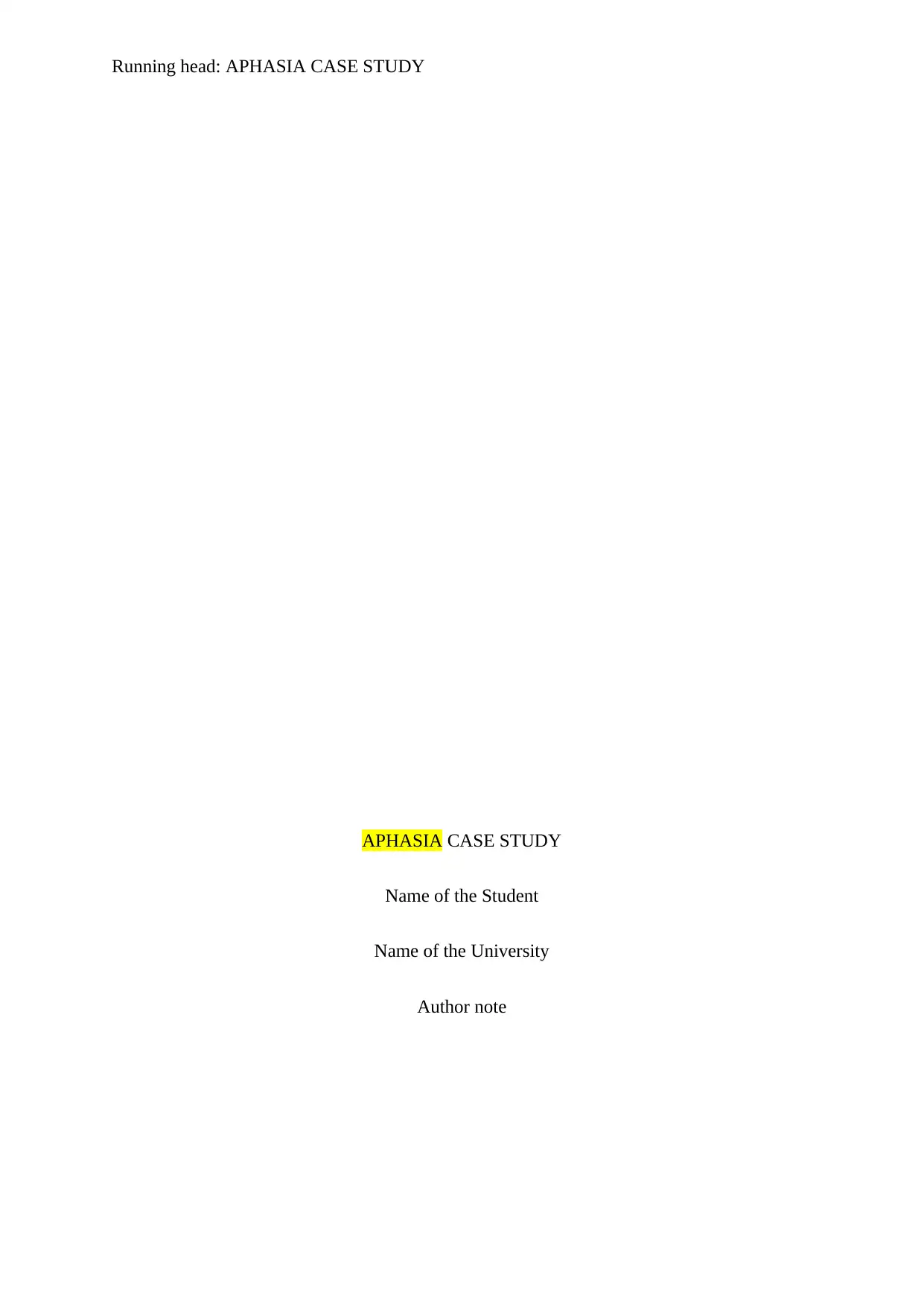
Running head: APHASIA CASE STUDY
APHASIA CASE STUDY
Name of the Student
Name of the University
Author note
APHASIA CASE STUDY
Name of the Student
Name of the University
Author note
Paraphrase This Document
Need a fresh take? Get an instant paraphrase of this document with our AI Paraphraser
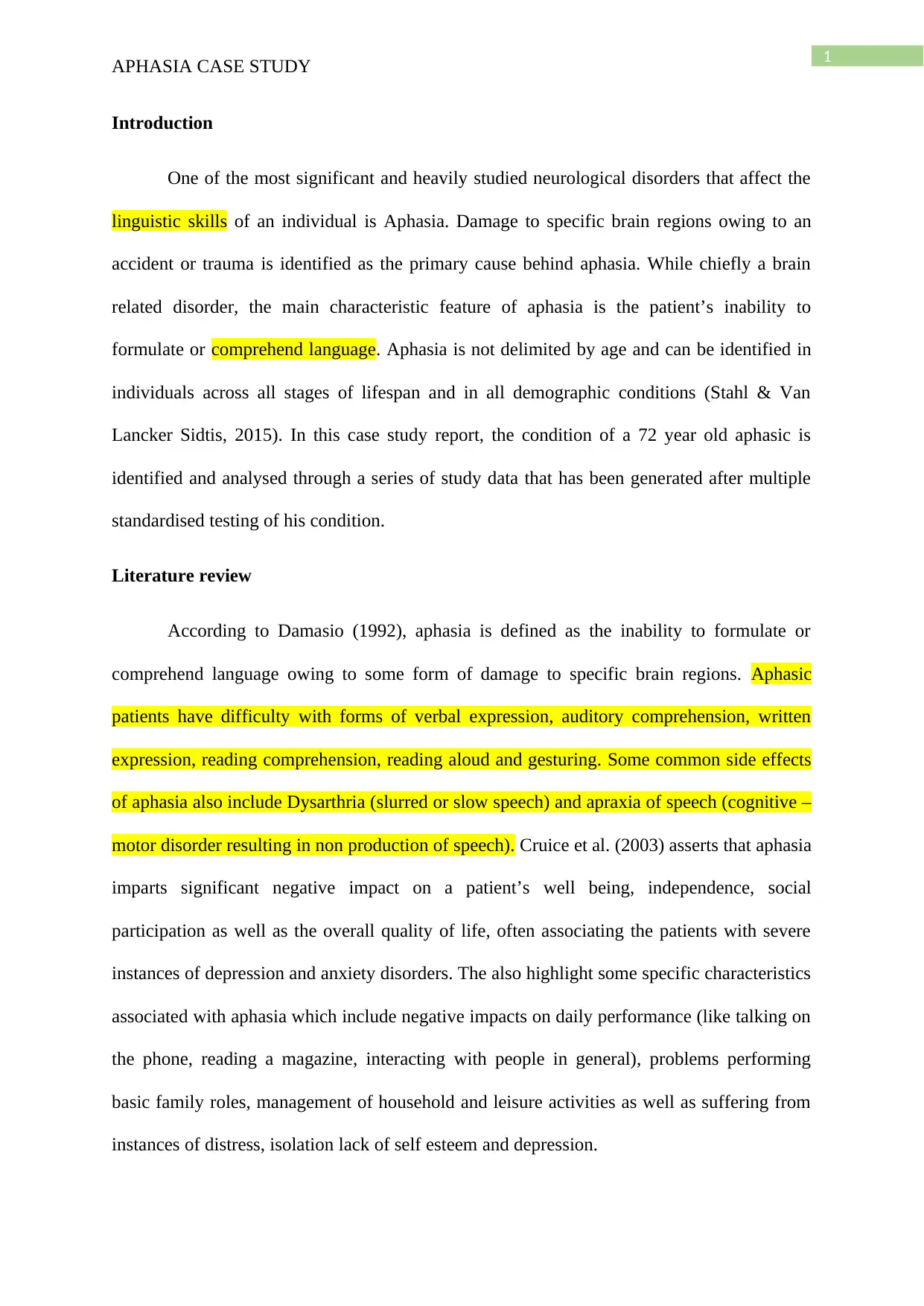
1
APHASIA CASE STUDY
Introduction
One of the most significant and heavily studied neurological disorders that affect the
linguistic skills of an individual is Aphasia. Damage to specific brain regions owing to an
accident or trauma is identified as the primary cause behind aphasia. While chiefly a brain
related disorder, the main characteristic feature of aphasia is the patient’s inability to
formulate or comprehend language. Aphasia is not delimited by age and can be identified in
individuals across all stages of lifespan and in all demographic conditions (Stahl & Van
Lancker Sidtis, 2015). In this case study report, the condition of a 72 year old aphasic is
identified and analysed through a series of study data that has been generated after multiple
standardised testing of his condition.
Literature review
According to Damasio (1992), aphasia is defined as the inability to formulate or
comprehend language owing to some form of damage to specific brain regions. Aphasic
patients have difficulty with forms of verbal expression, auditory comprehension, written
expression, reading comprehension, reading aloud and gesturing. Some common side effects
of aphasia also include Dysarthria (slurred or slow speech) and apraxia of speech (cognitive –
motor disorder resulting in non production of speech). Cruice et al. (2003) asserts that aphasia
imparts significant negative impact on a patient’s well being, independence, social
participation as well as the overall quality of life, often associating the patients with severe
instances of depression and anxiety disorders. The also highlight some specific characteristics
associated with aphasia which include negative impacts on daily performance (like talking on
the phone, reading a magazine, interacting with people in general), problems performing
basic family roles, management of household and leisure activities as well as suffering from
instances of distress, isolation lack of self esteem and depression.
APHASIA CASE STUDY
Introduction
One of the most significant and heavily studied neurological disorders that affect the
linguistic skills of an individual is Aphasia. Damage to specific brain regions owing to an
accident or trauma is identified as the primary cause behind aphasia. While chiefly a brain
related disorder, the main characteristic feature of aphasia is the patient’s inability to
formulate or comprehend language. Aphasia is not delimited by age and can be identified in
individuals across all stages of lifespan and in all demographic conditions (Stahl & Van
Lancker Sidtis, 2015). In this case study report, the condition of a 72 year old aphasic is
identified and analysed through a series of study data that has been generated after multiple
standardised testing of his condition.
Literature review
According to Damasio (1992), aphasia is defined as the inability to formulate or
comprehend language owing to some form of damage to specific brain regions. Aphasic
patients have difficulty with forms of verbal expression, auditory comprehension, written
expression, reading comprehension, reading aloud and gesturing. Some common side effects
of aphasia also include Dysarthria (slurred or slow speech) and apraxia of speech (cognitive –
motor disorder resulting in non production of speech). Cruice et al. (2003) asserts that aphasia
imparts significant negative impact on a patient’s well being, independence, social
participation as well as the overall quality of life, often associating the patients with severe
instances of depression and anxiety disorders. The also highlight some specific characteristics
associated with aphasia which include negative impacts on daily performance (like talking on
the phone, reading a magazine, interacting with people in general), problems performing
basic family roles, management of household and leisure activities as well as suffering from
instances of distress, isolation lack of self esteem and depression.
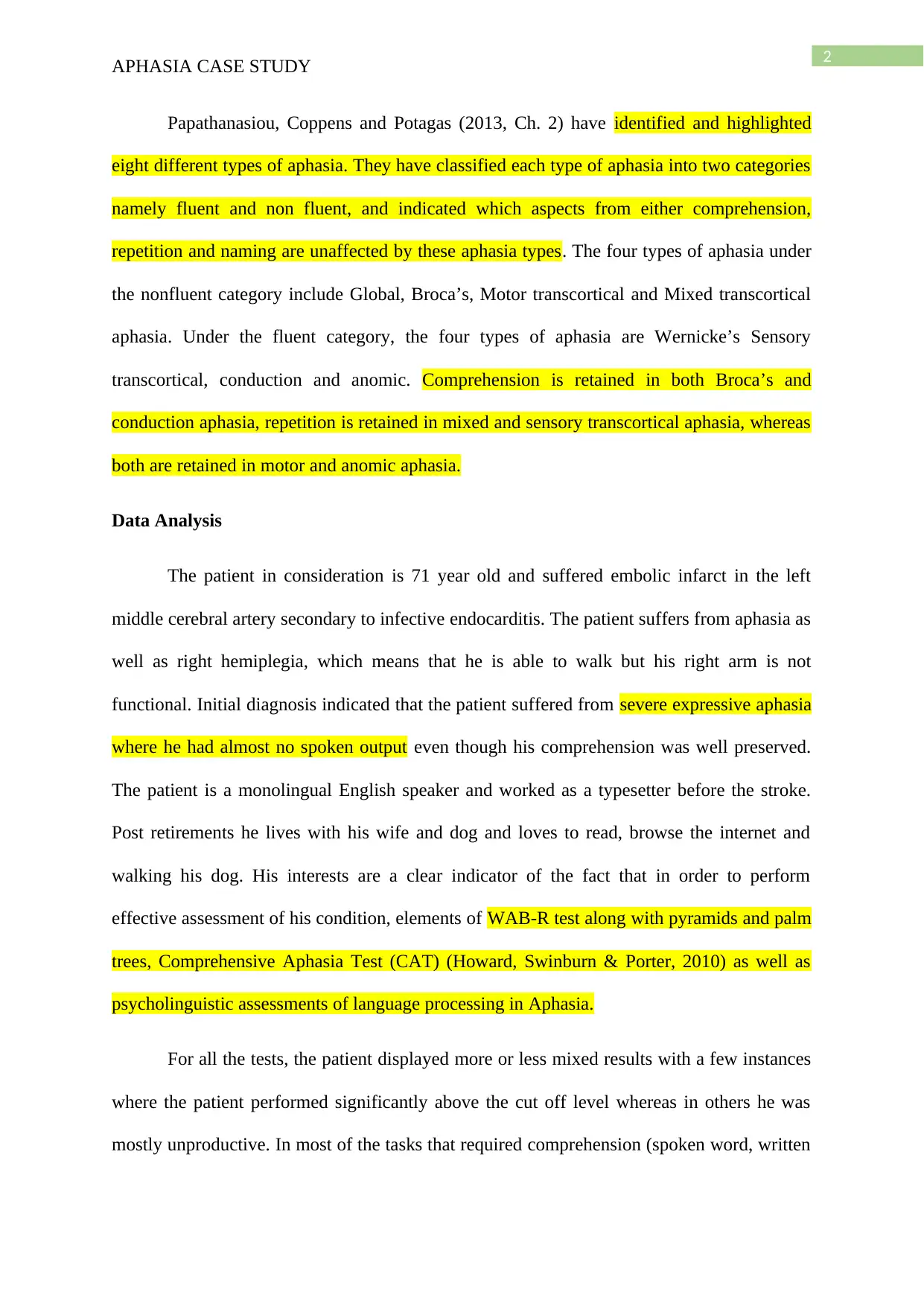
2
APHASIA CASE STUDY
Papathanasiou, Coppens and Potagas (2013, Ch. 2) have identified and highlighted
eight different types of aphasia. They have classified each type of aphasia into two categories
namely fluent and non fluent, and indicated which aspects from either comprehension,
repetition and naming are unaffected by these aphasia types. The four types of aphasia under
the nonfluent category include Global, Broca’s, Motor transcortical and Mixed transcortical
aphasia. Under the fluent category, the four types of aphasia are Wernicke’s Sensory
transcortical, conduction and anomic. Comprehension is retained in both Broca’s and
conduction aphasia, repetition is retained in mixed and sensory transcortical aphasia, whereas
both are retained in motor and anomic aphasia.
Data Analysis
The patient in consideration is 71 year old and suffered embolic infarct in the left
middle cerebral artery secondary to infective endocarditis. The patient suffers from aphasia as
well as right hemiplegia, which means that he is able to walk but his right arm is not
functional. Initial diagnosis indicated that the patient suffered from severe expressive aphasia
where he had almost no spoken output even though his comprehension was well preserved.
The patient is a monolingual English speaker and worked as a typesetter before the stroke.
Post retirements he lives with his wife and dog and loves to read, browse the internet and
walking his dog. His interests are a clear indicator of the fact that in order to perform
effective assessment of his condition, elements of WAB-R test along with pyramids and palm
trees, Comprehensive Aphasia Test (CAT) (Howard, Swinburn & Porter, 2010) as well as
psycholinguistic assessments of language processing in Aphasia.
For all the tests, the patient displayed more or less mixed results with a few instances
where the patient performed significantly above the cut off level whereas in others he was
mostly unproductive. In most of the tasks that required comprehension (spoken word, written
APHASIA CASE STUDY
Papathanasiou, Coppens and Potagas (2013, Ch. 2) have identified and highlighted
eight different types of aphasia. They have classified each type of aphasia into two categories
namely fluent and non fluent, and indicated which aspects from either comprehension,
repetition and naming are unaffected by these aphasia types. The four types of aphasia under
the nonfluent category include Global, Broca’s, Motor transcortical and Mixed transcortical
aphasia. Under the fluent category, the four types of aphasia are Wernicke’s Sensory
transcortical, conduction and anomic. Comprehension is retained in both Broca’s and
conduction aphasia, repetition is retained in mixed and sensory transcortical aphasia, whereas
both are retained in motor and anomic aphasia.
Data Analysis
The patient in consideration is 71 year old and suffered embolic infarct in the left
middle cerebral artery secondary to infective endocarditis. The patient suffers from aphasia as
well as right hemiplegia, which means that he is able to walk but his right arm is not
functional. Initial diagnosis indicated that the patient suffered from severe expressive aphasia
where he had almost no spoken output even though his comprehension was well preserved.
The patient is a monolingual English speaker and worked as a typesetter before the stroke.
Post retirements he lives with his wife and dog and loves to read, browse the internet and
walking his dog. His interests are a clear indicator of the fact that in order to perform
effective assessment of his condition, elements of WAB-R test along with pyramids and palm
trees, Comprehensive Aphasia Test (CAT) (Howard, Swinburn & Porter, 2010) as well as
psycholinguistic assessments of language processing in Aphasia.
For all the tests, the patient displayed more or less mixed results with a few instances
where the patient performed significantly above the cut off level whereas in others he was
mostly unproductive. In most of the tasks that required comprehension (spoken word, written
⊘ This is a preview!⊘
Do you want full access?
Subscribe today to unlock all pages.

Trusted by 1+ million students worldwide
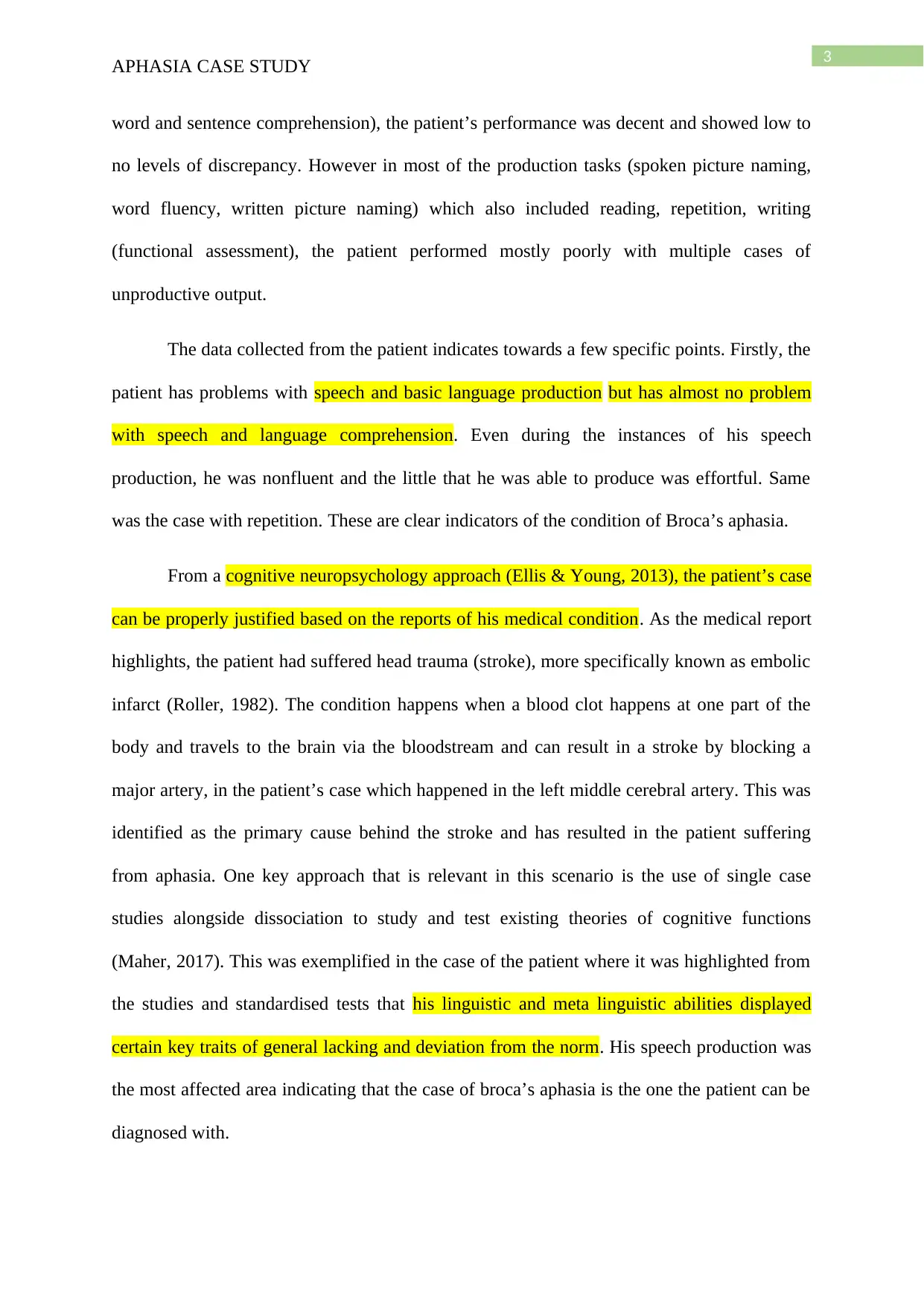
3
APHASIA CASE STUDY
word and sentence comprehension), the patient’s performance was decent and showed low to
no levels of discrepancy. However in most of the production tasks (spoken picture naming,
word fluency, written picture naming) which also included reading, repetition, writing
(functional assessment), the patient performed mostly poorly with multiple cases of
unproductive output.
The data collected from the patient indicates towards a few specific points. Firstly, the
patient has problems with speech and basic language production but has almost no problem
with speech and language comprehension. Even during the instances of his speech
production, he was nonfluent and the little that he was able to produce was effortful. Same
was the case with repetition. These are clear indicators of the condition of Broca’s aphasia.
From a cognitive neuropsychology approach (Ellis & Young, 2013), the patient’s case
can be properly justified based on the reports of his medical condition. As the medical report
highlights, the patient had suffered head trauma (stroke), more specifically known as embolic
infarct (Roller, 1982). The condition happens when a blood clot happens at one part of the
body and travels to the brain via the bloodstream and can result in a stroke by blocking a
major artery, in the patient’s case which happened in the left middle cerebral artery. This was
identified as the primary cause behind the stroke and has resulted in the patient suffering
from aphasia. One key approach that is relevant in this scenario is the use of single case
studies alongside dissociation to study and test existing theories of cognitive functions
(Maher, 2017). This was exemplified in the case of the patient where it was highlighted from
the studies and standardised tests that his linguistic and meta linguistic abilities displayed
certain key traits of general lacking and deviation from the norm. His speech production was
the most affected area indicating that the case of broca’s aphasia is the one the patient can be
diagnosed with.
APHASIA CASE STUDY
word and sentence comprehension), the patient’s performance was decent and showed low to
no levels of discrepancy. However in most of the production tasks (spoken picture naming,
word fluency, written picture naming) which also included reading, repetition, writing
(functional assessment), the patient performed mostly poorly with multiple cases of
unproductive output.
The data collected from the patient indicates towards a few specific points. Firstly, the
patient has problems with speech and basic language production but has almost no problem
with speech and language comprehension. Even during the instances of his speech
production, he was nonfluent and the little that he was able to produce was effortful. Same
was the case with repetition. These are clear indicators of the condition of Broca’s aphasia.
From a cognitive neuropsychology approach (Ellis & Young, 2013), the patient’s case
can be properly justified based on the reports of his medical condition. As the medical report
highlights, the patient had suffered head trauma (stroke), more specifically known as embolic
infarct (Roller, 1982). The condition happens when a blood clot happens at one part of the
body and travels to the brain via the bloodstream and can result in a stroke by blocking a
major artery, in the patient’s case which happened in the left middle cerebral artery. This was
identified as the primary cause behind the stroke and has resulted in the patient suffering
from aphasia. One key approach that is relevant in this scenario is the use of single case
studies alongside dissociation to study and test existing theories of cognitive functions
(Maher, 2017). This was exemplified in the case of the patient where it was highlighted from
the studies and standardised tests that his linguistic and meta linguistic abilities displayed
certain key traits of general lacking and deviation from the norm. His speech production was
the most affected area indicating that the case of broca’s aphasia is the one the patient can be
diagnosed with.
Paraphrase This Document
Need a fresh take? Get an instant paraphrase of this document with our AI Paraphraser

4
APHASIA CASE STUDY
APHASIA CASE STUDY
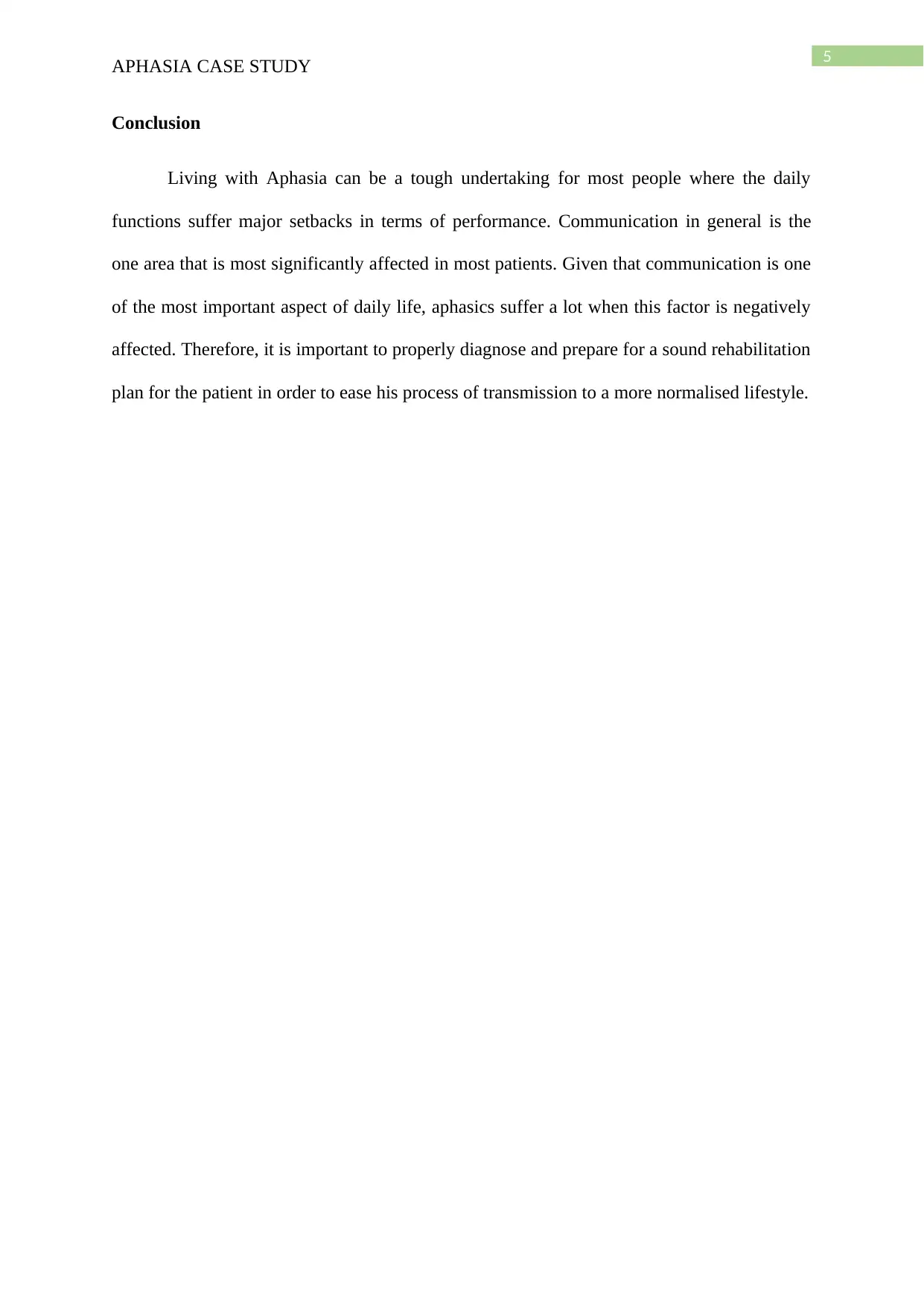
5
APHASIA CASE STUDY
Conclusion
Living with Aphasia can be a tough undertaking for most people where the daily
functions suffer major setbacks in terms of performance. Communication in general is the
one area that is most significantly affected in most patients. Given that communication is one
of the most important aspect of daily life, aphasics suffer a lot when this factor is negatively
affected. Therefore, it is important to properly diagnose and prepare for a sound rehabilitation
plan for the patient in order to ease his process of transmission to a more normalised lifestyle.
APHASIA CASE STUDY
Conclusion
Living with Aphasia can be a tough undertaking for most people where the daily
functions suffer major setbacks in terms of performance. Communication in general is the
one area that is most significantly affected in most patients. Given that communication is one
of the most important aspect of daily life, aphasics suffer a lot when this factor is negatively
affected. Therefore, it is important to properly diagnose and prepare for a sound rehabilitation
plan for the patient in order to ease his process of transmission to a more normalised lifestyle.
⊘ This is a preview!⊘
Do you want full access?
Subscribe today to unlock all pages.

Trusted by 1+ million students worldwide
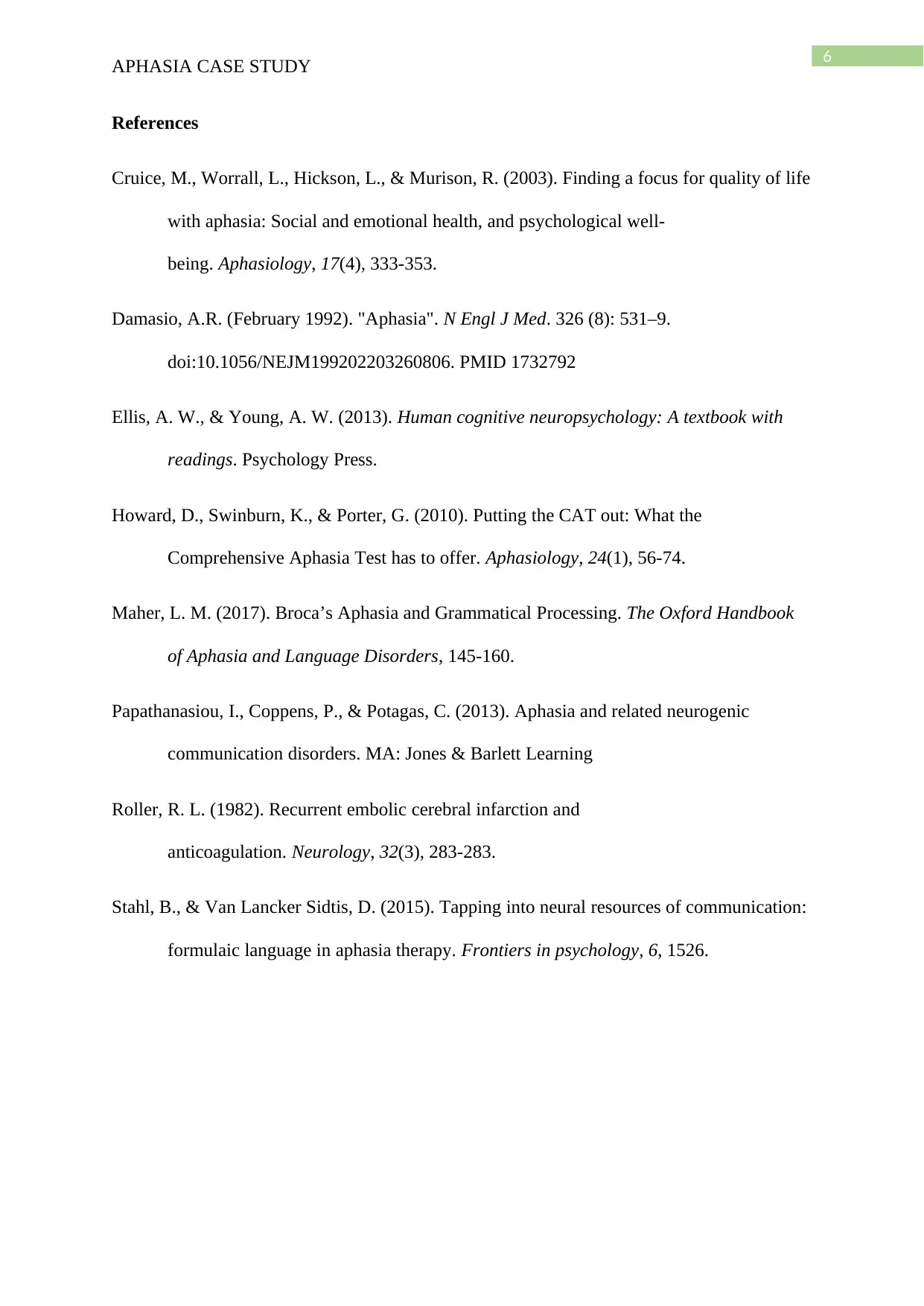
6
APHASIA CASE STUDY
References
Cruice, M., Worrall, L., Hickson, L., & Murison, R. (2003). Finding a focus for quality of life
with aphasia: Social and emotional health, and psychological well-
being. Aphasiology, 17(4), 333-353.
Damasio, A.R. (February 1992). "Aphasia". N Engl J Med. 326 (8): 531–9.
doi:10.1056/NEJM199202203260806. PMID 1732792
Ellis, A. W., & Young, A. W. (2013). Human cognitive neuropsychology: A textbook with
readings. Psychology Press.
Howard, D., Swinburn, K., & Porter, G. (2010). Putting the CAT out: What the
Comprehensive Aphasia Test has to offer. Aphasiology, 24(1), 56-74.
Maher, L. M. (2017). Broca’s Aphasia and Grammatical Processing. The Oxford Handbook
of Aphasia and Language Disorders, 145-160.
Papathanasiou, I., Coppens, P., & Potagas, C. (2013). Aphasia and related neurogenic
communication disorders. MA: Jones & Barlett Learning
Roller, R. L. (1982). Recurrent embolic cerebral infarction and
anticoagulation. Neurology, 32(3), 283-283.
Stahl, B., & Van Lancker Sidtis, D. (2015). Tapping into neural resources of communication:
formulaic language in aphasia therapy. Frontiers in psychology, 6, 1526.
APHASIA CASE STUDY
References
Cruice, M., Worrall, L., Hickson, L., & Murison, R. (2003). Finding a focus for quality of life
with aphasia: Social and emotional health, and psychological well-
being. Aphasiology, 17(4), 333-353.
Damasio, A.R. (February 1992). "Aphasia". N Engl J Med. 326 (8): 531–9.
doi:10.1056/NEJM199202203260806. PMID 1732792
Ellis, A. W., & Young, A. W. (2013). Human cognitive neuropsychology: A textbook with
readings. Psychology Press.
Howard, D., Swinburn, K., & Porter, G. (2010). Putting the CAT out: What the
Comprehensive Aphasia Test has to offer. Aphasiology, 24(1), 56-74.
Maher, L. M. (2017). Broca’s Aphasia and Grammatical Processing. The Oxford Handbook
of Aphasia and Language Disorders, 145-160.
Papathanasiou, I., Coppens, P., & Potagas, C. (2013). Aphasia and related neurogenic
communication disorders. MA: Jones & Barlett Learning
Roller, R. L. (1982). Recurrent embolic cerebral infarction and
anticoagulation. Neurology, 32(3), 283-283.
Stahl, B., & Van Lancker Sidtis, D. (2015). Tapping into neural resources of communication:
formulaic language in aphasia therapy. Frontiers in psychology, 6, 1526.
1 out of 7
Related Documents
Your All-in-One AI-Powered Toolkit for Academic Success.
+13062052269
info@desklib.com
Available 24*7 on WhatsApp / Email
![[object Object]](/_next/static/media/star-bottom.7253800d.svg)
Unlock your academic potential
Copyright © 2020–2025 A2Z Services. All Rights Reserved. Developed and managed by ZUCOL.



